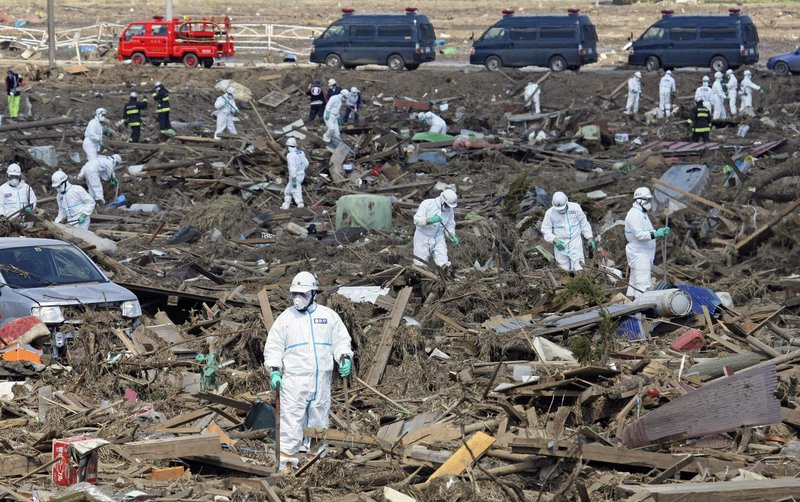Highly toxic plutonium is seeping from the damaged nuclear power plant in Japan’s tsunami disaster zone into the soil outside, officials said today, heightening concerns about the expanding spread of radiation.
Plutonium was detected at several spots outside the Fukushima Dai-ichi power plant — the first confirmed presence of the dangerously radioactive substance, plant operator Tokyo Electric Power Co. said.
There are strong indications some of the radioactivity is coming from damaged nuclear fuel rods, a worrying development in the race to bring the power plant under control, Chief Cabinet Secretary Yukio Edano said Tuesday.
“The situation is very grave,” Edano told reporters. “We are doing our utmost efforts to contain the damage.”
Officials said the traces of plutonium posed no immediate threat to public health. But the latest finding appeared to feed government frustration with TEPCO, which has failed to stem the crisis more than two weeks after an earthquake and tsunami damaged the plant.
The failure to keep radioactive substances from seeping out of the facility was “deplorable,” said Hidehiko Nishiyama, a spokesman for the Nuclear and Industrial Safety Agency.
The government is considering temporarily nationalizing the troubled nuclear plant operator, Japan’s top-selling daily Yomiuri said Tuesday, quoting unnamed government sources.
The huge tsunami spawned by the earthquake destroyed the power systems needed to cool the nuclear fuel rods in the complex, 140 miles from Tokyo.
Since then, three of the complex’s six reactors are believed to have partially melted down, and emergency crews have struggled with everything from malfunctioning pumps to dangerous spikes in radiation that have forced temporary evacuations of workers. Residents within a 19-mile radius of the plant have been urged to leave or stay indoors.
Confusion at the plant has intensified fears that the nuclear crisis will continue for months or even years amid alarms over radiation making its way into food and even tap water as far away as Tokyo.
The troubles have eclipsed Pennsylvania’s 1979 crisis at Three Mile Island, when a partial meltdown raised fears of widespread radiation release. But it is still well short of the 1986 Chernobyl disaster, which killed at least 31 people with radiation sickness, raised long-term cancer rates and spewed radiation across much of the northern hemisphere.
While parts of the Japanese plant have been reconnected to the power grid, contaminated water found in numerous places around the complex, including the basements of several buildings, must be pumped out before electricity can be restored to the cooling system.
The contaminated water has been emitting radiation exposure more than four times the amount the government considers safe for workers.
That has left officials struggling with two sometimes-contradictory efforts: pumping in water to keep the fuel rods cool and pumping out — and then safely storing — contaminated water.
Nishiyama called it “very delicate work.” He said workers are looking for safe ways to store the radioactive water.
Experts are also trying to pinpoint the source of the radioactive water. Many now suspect it is cooling water that has leaked from one of the disabled reactors.
Meanwhile, new readings showed ocean contamination had spread about a mile farther north of the nuclear site than before, but was still within the evacuation zone. Radioactive iodine-131 was discovered offshore at a level 1,150 times higher than normal, NISA said.
Closer to the plant, radioactivity in seawater tested about 1,250 times higher than normal last week and climbed to 1,850 times normal over the weekend.
Of the five soil samples showing plutonium, two appeared to be coming from leaking reactors while the rest were likely the result of years of nuclear tests that left trace amounts of plutonium in many places around the world, TEPCO said.
Plutonium is a heavy element that doesn’t readily combine with other elements, so it is less likely to spread than lighter, more volatile radioactive materials detected around the site, such as the radioactive forms of cesium and iodine.
“The relative toxicity of plutonium is much higher than that of iodine or cesium but the chance of people getting a dose of it is much lower,” says Robert Henkin, professor emeritus of radiology at Loyola University’s Stritch School of Medicine. “Plutonium just sits there and is a nasty actor.”
Send questions/comments to the editors.



Success. Please wait for the page to reload. If the page does not reload within 5 seconds, please refresh the page.
Enter your email and password to access comments.
Hi, to comment on stories you must . This profile is in addition to your subscription and website login.
Already have a commenting profile? .
Invalid username/password.
Please check your email to confirm and complete your registration.
Only subscribers are eligible to post comments. Please subscribe or login first for digital access. Here’s why.
Use the form below to reset your password. When you've submitted your account email, we will send an email with a reset code.